May 29, 2025 | 15:11 GMT +7
May 29, 2025 | 15:11 GMT +7
Hotline: 0913.378.918
May 29, 2025 | 15:11 GMT +7
Hotline: 0913.378.918
At Mr. La Van Hanh's 18-hectare field in Truong Long Tay commune (Chau Thanh A district, Hau Giang province), at 6 a.m., the drone (an unmanned aerial vehicle) carrying dozens of kilograms of OM5451 rice seed started sowing according to the smart rice farming process applying the alternate wetting and drying (AWD) irrigation technique.
The model is jointly implemented by four businesses: Net Zero Carbon Joint Stock Company, BSB Nanotechnology Joint Stock Company (BSB Nanotech), MTK Huu Thanh Joint Stock Company, and Spiro Carbon.
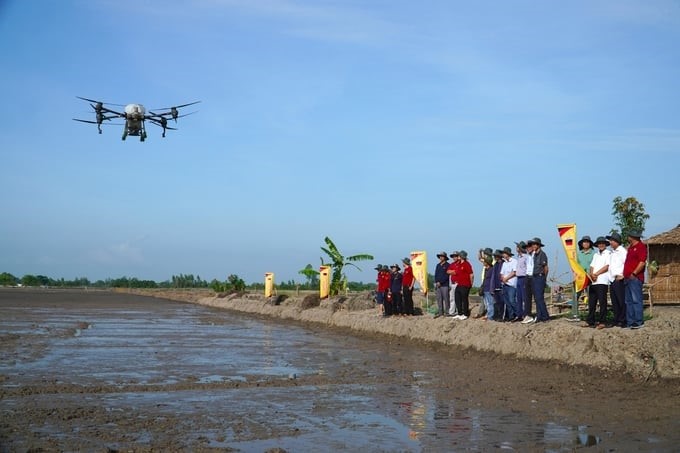
This is the largest model in Hau Giang province applying the smart rice farming process, alternate wetting and drying (AWD) irrigation, implemented by businesses. Photo: Van Vu.
The rice variety put into production in the model has a growing time of 95–105 days. The total time to keep the field wet is about 50 days, and the time to keep the field dry is about 50 days. In particular, farmers need to divide it four times to get water into the field and five times to release water.
The number of dry and wet days is calculated by agricultural experts in accordance with the growth and development phases of rice plants. Thereby, helping farmers manage weeds well, increasing the number of effective shoots, and limiting pests.
In the period from 85 days after sowing (NSS), farmers release water to let the field surface dry naturally. 10–14 days before harvesting, it is necessary to tighten water so that the field surface is dry, helping to improve rice quality and facilitate the use of machinery when harvesting. Proper cultivation according to the AWD irrigation process can help farmers reduce emissions by 3.5–4 tons/ha/crop.
Particularly, during the farming process, farmers are guided by agricultural engineers to take photos of the field at the following times: Preparation for sowing, 18 NSS, 37 NSS, 44 NSS, 55 NSS, 70 NSS, and 100 NSS. At the same time, the Spiro Carbon satellite system will fly over the field that has been located on the system six times to take photos and measure gas emissions, including three times when the field is wet and three times when the field is dry.
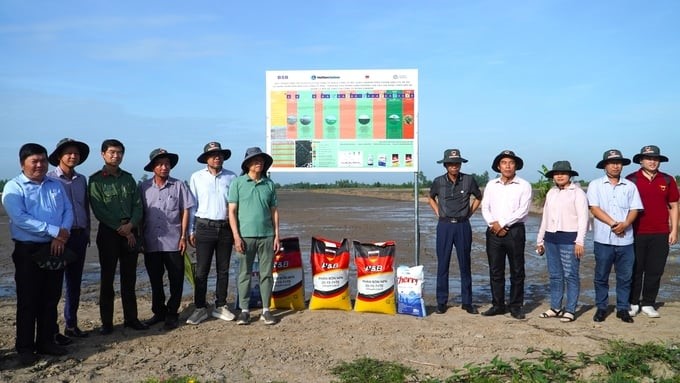
The linkage between four businesses contributes to closing the smart rice growing process, helping farmers reduce production costs, creating quality and safe rice products, and reducing emissions. Photo: Kim Anh.
Mr. La Van Hanh (the household participating in the model) said that previously, he had also applied the AWD rice farming process, but when approaching the smart rice farming method this time, he realized that the process is applied more strictly and tightly.
The smart rice farming process applying the AWD irrigation technique has been successfully implemented in Thailand and continues to be replicated in many provinces and cities of Vietnam in recent years.
Typically, Binh Hoa commune (Krong Ana district, Dak Lak province) is the first locality chosen by businesses to pilot the process on a scale of 4 hectares. At the end of May, the fields were harvested with very positive results. Farmers reduced the amount of irrigation water by half and production costs by 15%. In particular, productivity increased by 2 tons/ha compared to the previous farming method.
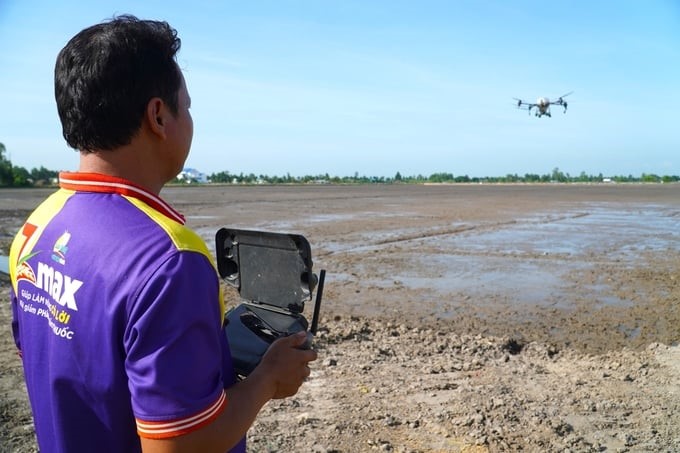
The entire farming process maximizes the power of science and technology, reducing "footprints" on the field. Photo: Van Vu.
The successful model has created great motivation for farmers and the agricultural sector of Dak Lak province to boldly switch to the smart rice farming method that increases product value and protects the environment.
From here, the process continues to be expanded in some Mekong Delta localities, such as Dong Thap, Kien Giang, and Hau Giang. Particularly, the model in Dong Thap province just completing harvest achieved positive results when the yield reached 8.8 tons/ha. Meanwhile, the control field reached over 7 tons/ha, and the fields in the area only reached about 6 tons/ha.
To effectively deploy the model, Net Zero Carbon Company is the unit that presides, coordinates, and organizes the implementation and general management of the entire model.
BSB Nanotech is the unit that provides farming solutions, monitors, and guides farmers to implement AWD irrigation solutions. And the process of applying the ECO OK product with nanocomposites, including effective silica from rice husks, boron, and nanosilver, combined with Cherry micronutrient fertilizer to help rice plants stay healthy and develop good roots. Thereby contributing to improving the "health" and resistance of rice plants to the adverse effects of weather and pests, promoting the development of circular agriculture, and creating safe and eco-friendly products.
Participating in the model, MTK Huu Thanh Joint Stock Company provides one-color smart fertilizer specialized for rice. Combined with a scientific farming process, this product is a solution to help reduce input costs, help rice plants stay strong, and have fewer pests.
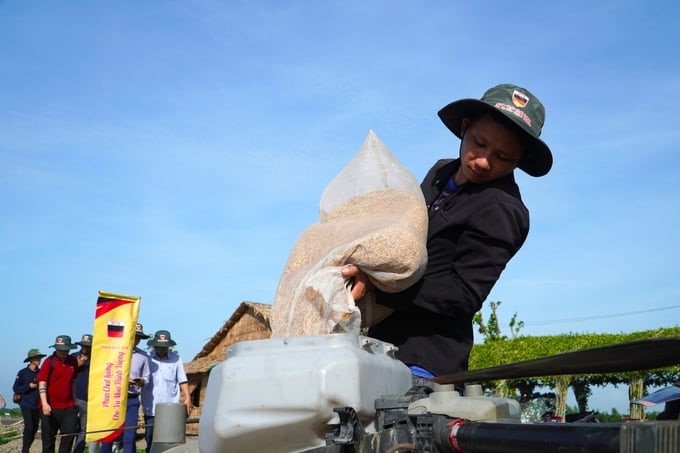
The model uses the rice variety OM5451, with a sowing amount of 80 kg/ha. Photo: Kim Anh.
In the model, Spiro Carbon will provide solutions to observe, measure, evaluate, and report on the amount of greenhouse gas emissions from rice plants. This business is responsible for operating the satellite system to monitor and photograph the entire development process of the rice field. After the end of the crop, based on the collected data, the unit will analyze, evaluate, propose emission reduction levels, and issue reports.
This linkage aims to create a closed smart rice growing process, from the unit supplying input materials to providing technical solutions and providing solutions to observe, measure, and report on the amount of greenhouse gas emissions.
With the desire to optimize costs and improve rice productivity and quality for farmers, Mr. Tran Minh Tien, General Director of Net Zero Carbon Joint Stock Company, confidently commits that the AWD process will help farmers reduce the costs of using pesticides by about 30% and chemical fertilizer by about 10%. Thus, the economic efficiency of smart rice farming will significantly increase. Rice seeds are cleaner and "greener"; increase productivity; reduce emissions; and improve the health of rice growers.
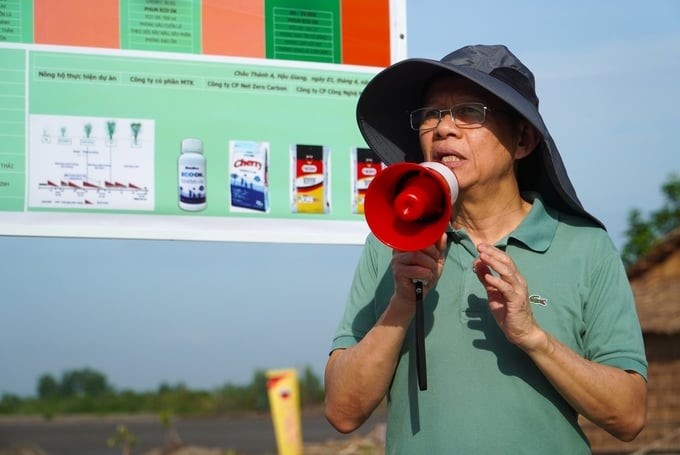
Mr. Tran Minh Tien, General Director of Net Zero Carbon Joint Stock Company, wishes to partially participate in the project on 1 million hectares of high-quality rice in the Mekong Delta region. Photo: Kim Anh.
This farming process is quite new compared to farmers' current farming practices, so to help farmers feel secure, Net Zero Carbon implements an "offsetting" policy for farmers if the output from the model is lower than the district average. On the contrary, if the output is higher, people will fully enjoy the results.
With this direction, the unit wishes to be able to partially participate in the 1 Million Hectares of High-Quality Rice Project that the Ministry of Agriculture and Rural Development is implementing.
This comprehensive science and technology application solution has brought positive and outstanding results to farmers and the natural environment, opening up prospects consistent with the green, sustainable, and high-quality development orientation that the agricultural sector of the country in general and the Mekong Delta region in particular is aiming for.
Production linkage in smart rice farming models applying the alternate wetting and drying irrigation technique will help maximize the exploitation of each business's strengths and gather them into one process to create an effective farming solution that ensures the following criteria: Reduce costs, improve the "health" of rice plants, increase productivity, reduce emissions, and protect the environment.
The smart rice farming process applying alternate wetting and drying (AWD) irrigation is expected to create breakthroughs in sustainable rice cultivation in many regions across the country.
Translated by Thu Huyen
/2025/05/25/4127-3-073637_820.jpg)
(VAN) Thanks to the promotion from an FAO-implemented project, vegetable production in greenhouses in Moc Chau has seen strong development, from 1.5 hectares in 2021 to nearly 50 hectares in 2024.

(VAN) FAO has recently supported USD 140,000 to implement the project 'Risk mitigation human-animal interface risks through disease control initiatives in pig farming.'

(VAN) The People's Committee of Tra Vinh province has approved an adjustment to the investment policy for the Green Hydrogen Plant project, increasing its area to approximately 52.76 hectares.
![Reducing emissions from rice fields: [2] Farmers’ commitment to the soil](https://t.ex-cdn.com/nongnghiepmoitruong.vn/608w/files/news/2025/05/05/dsc08881jpg-nongnghiep-140632.jpg)
(VAN) Clean rice cultivation model in Thuong Tan commune, Bac Tan Uyen district, is assisting local residents in achieving sustainable agriculture by substantially reducing costs, increasing productivity, and protecting the environment.

(VAN) At the conference to disseminate Resolution No. 68, AgriS introduced its digital agricultural ecosystem and reaffirmed its commitment to accompanying the Government in promoting private sector development and sustainable agriculture.

(VAN) 'Blue Ocean - Blue Foods' initiative is designed to restore marine ecosystems and establish sustainable livelihoods for local communities by cultivating a minimum of 1,000 hectares of cottonii seaweed in the first three years.
/2025/05/21/4642-3-112707_603.jpg)
(VAN) The V-SCOPE project has made direct contributions to three out of six pillars of the Comprehensive Strategic Partnership between Vietnam and Australia.